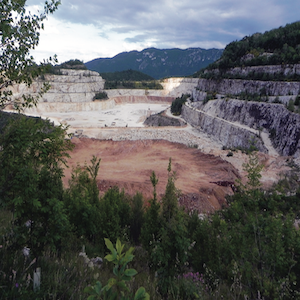Spontaneous renaturalization of open ecosystems in the hills of Brescia seen through the bird community

Accepted: 17 May 2023
All claims expressed in this article are solely those of the authors and do not necessarily represent those of their affiliated organizations, or those of the publisher, the editors and the reviewers. Any product that may be evaluated in this article or claim that may be made by its manufacturer is not guaranteed or endorsed by the publisher.
Authors
The sun-exposed open areas of the Brescia hills overlooking the Po Valley (Avanalpica region) were created by man starting from the 11th century. After the Second World War, following agro-pastoral abandonment, these areas have significantly shrunk. The evolution underway is towards the deciduous forest although in some areas the strong presence of quarries is blocking the vegetational succession or delaying it. Local birds are now largely associated with woodland coenosis and more scarcely with open areas, shrublands and wood edges. Seven open areas species have become extinct over the past 30 years: Woodchat Shrike, Barred Warbler, Rufous-tailed Rock-Thrush, Eastern Black-eared Wheatear, Tawny Pipit, Corn Bunting and Ortolan Bunting. Others, like Red-backed Shrike, Common Whitethroat, Cirl Bunting and Wood Lark have declined. Only the generalist Sardinian Warbler and Blue Rock-Thrush, typical of rocky areas with grassy spaces, are still relatively widespread although slightly decreasing. The Cirl Bunting, a species linked to traditional vineyards and orchards, is not expanding in the new intensively cultivated lands. The Eastern Subalpine Warbler is on the rise even though, due to its very low presence and lack of specific surveys, it may not have been detected in the past. The factors determining the presence of these species, i.e. traditional crops, flat open areas, soils with low grass and often with outcropping and/or rocky substrate, are in sharp decline. We can state that this bird community is negatively influenced by the percentage of tree cover and positively influenced by the presence of quarries which, however, represent an ephemeral and strongly impacting environment. In the absence of fires and/or natural disasters as well as human interventions, which are not likely to occur due to their poor economic sustainability, the prognosis for these birds is to be considered poor and a reduction in both bird and general biodiversity is to be expected.
Downloads
Citations
PlumX Metrics
PlumX Metrics provide insights into the ways people interact with individual pieces of research output (articles, conference proceedings, book chapters, and many more) in the online environment. Collectively known as PlumX Metrics, these metrics are divided into five categories to help make sense of the huge amounts of data involved and to enable analysis by comparing like with like.
How to Cite

This work is licensed under a Creative Commons Attribution-NonCommercial 4.0 International License.
PAGEPress has chosen to apply the Creative Commons Attribution NonCommercial 4.0 International License (CC BY-NC 4.0) to all manuscripts to be published.
Similar Articles
- Luca Maurino, Data on Rock Partridge, Alectoris graeca, spring counts in the territory of the Natural Park Val Troncea (Piedmont Region) , Rivista Italiana di Ornitologia: Vol. 82 No. 1-2 (2012)
- Francesca Coccon, Stefano Borella, Nicola Simeoni, Stefano Malavasi, Floating rafts as breeding habitats for the Common tern, Sterna hirundo. Colonization patterns, abundance and reproductive success in Venice Lagoon , Rivista Italiana di Ornitologia: Vol. 88 No. 1 (2018)
- Flavio Ferlini, Österreichischer Brutvogelatlas 2013-2018 , Rivista Italiana di Ornitologia: Vol. 94 No. 1 (2024)
- Riccardo Groppali, Urban Birds in Cremona 11 years after. , Rivista Italiana di Ornitologia: Vol. 82 No. 1-2 (2012)
- Paolo Pedrini, Fernando Spina, [A brief history about the ALPI project] , Rivista Italiana di Ornitologia: Vol. 91 No. 2 (2021)
- Cristiano Liuzzi, Paola Pino d’Astore, Cosimo Gaspare Giannuzzi, Antonio Camarda, Nicola Baccetti, Largest colony of Audouin’s Gull (Larus audouinii) in the Adriatic Sea and the increasing value of Apulia for the Central/Eastern Mediterranean population , Rivista Italiana di Ornitologia: Vol. 93 No. 2 (2023)
- Roberto Guglielmi, Claudio Mancuso, Saverio Gatto, Gabriele Quarello, Adriano Argenio, Alessandro Leardi, Francesco Garofano, Gianbenedetto Ghiurmino, New data on the status of the Golden Eagle, Aquila chrysaetos, in Campania updated to 2007 , Rivista Italiana di Ornitologia: Vol. 82 No. 1-2 (2012)
- Flavio Ferlini, Elena Alexandrovna Artemyeva, Gombobaatar Sundev, The White-headed yellow wagtail Motacilla flava leucocephala (Przewalski, 1887): migration, movements, and breeding and wintering ranges , Rivista Italiana di Ornitologia: Vol. 91 No. 1 (2021)
- Tiziano Londei, A macrorhynchos-like Eurasian Nutcracker (Nucifraga caryocatactes) in the Dolomites with a very abraded ring: an aged immigrant, or a locally born bird? , Rivista Italiana di Ornitologia: Vol. 88 No. 2 (2018)
- Corrado Battisti, Veridiana Barucci, Valeria Concettini, Giuseppe Dodaro, Francesca Marini, Breeding birds of ‟Nomentum” nature reserve (central Italy): a forest remnant landscape surrounded by an agro-urbanized matrix , Rivista Italiana di Ornitologia: Vol. 92 No. 1 (2022)
<< < 7 8 9 10 11 12 13 14 > >>
You may also start an advanced similarity search for this article.


 https://doi.org/10.4081/rio.2023.667
https://doi.org/10.4081/rio.2023.667



